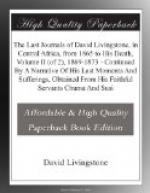10th December, 1870.—I am sorely let and hindered in this Manyuema. Rain every day, and often at night; I could not travel now, even if I had men, but I could make some progress; this is the sorest delay I ever had. I look above for help and mercy.
[The wearied man tried to while away the time by gaining little scraps of information from the Arabs and the natives, but we cannot fail to see what a serious stress was all the time put upon his constitution under these circumstances; the reader will pardon the disjointed nature of his narrative, written as it was under the greatest disadvantage.]
Lion’s fat is regarded as a sure preventive of tsetse or bungo. This was noted before, but I add now that it is smeared on the ox’s tail, and preserves hundreds of the Banyamwesi cattle in safety while going to the coast; it is also used to keep pigs and hippopotami away from gardens: the smell is probably the efficacious part in “Heresi,” as they call it.
12th December, 1870.—It may be all for the best that I am so hindered, and compelled to inactivity.
An advance to Lohombo was the furthest point of traders for many a day, for the slaves returning with ivory were speared mercilessly by Manyuema, because they did not know guns could kill, and their spears could. Katomba coming to Moenekuss was a great feat three or four years ago; then Dugumbe went on to Lualaba, and fought his way, so I may be restrained now in mercy till men come.
The Neggeri, an African animal, attacks the tenderest parts of man and beast, cuts them off, and retires contented: buffaloes are often castrated by him. Men who know it, squat down, and kill him with knife or gun. The Zibu or mbuide flies at the tendon Achilles; it is most likely the Ratel.
The Fisi ea bahari, probably the seal, is abundant in the seas, but the ratel or badger probably furnished the skins for the Tabernacle: bees escape from his urine, and he eats their honey in safety; lions and all other animals fear his attacks of the heel.
The Babemba mix a handful (about twenty-five to a measure) of castor-oil seeds with the dura and meleza they grind, and usage makes them like it, the nauseous taste is not perceptible in porridge; the oil is needed where so much farinaceous or starchy matter exists, and the bowels are regulated by the mixture: experience has taught them the need of a fatty ingredient.
[Dr. Livingstone seems to have been anxious to procure all the information possible from the Arabs respecting the powerful chief Merere, who is reported to live on the borders of the Salt Water Lake, which lies between Lake Tanganyika and the East Coast. It would seem as if Merere held the most available road for travellers passing to the south-west from Zanzibar, and although the Doctor did not go through his country, he felt an interest no doubt in ascertaining as much as he could for the benefit of others.]




